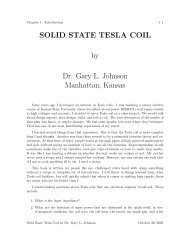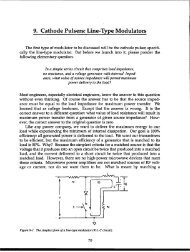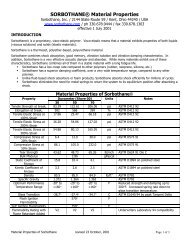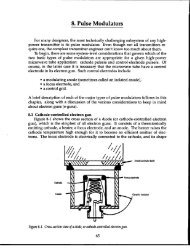3.6M north10.pdf - Dean-O's Toy Box
3.6M north10.pdf - Dean-O's Toy Box
3.6M north10.pdf - Dean-O's Toy Box
You also want an ePaper? Increase the reach of your titles
YUMPU automatically turns print PDFs into web optimized ePapers that Google loves.
184 High-Power Microwave-Tube Transmitters<br />
rebuilt.<br />
10.4.7 The L-5012 and L-5097 Injectronm beam-switch tubes<br />
We have seen how effective collinear electric and magnetic fields can be in<br />
minimizing grid current in the examples of the previous tubes. The L-5012<br />
Injectron beam-switch tube (BST), the smaller of the two tubes of this type, was<br />
the first vacuum switch tube to make a complete break from the conventional<br />
wire-type grid structure. Instead, it used a completely solid control electrode.<br />
How can electrons get through a solid metal electrode? They can’t, of course. But<br />
by using crossed rather than collinear magnetic and electric fields, they don’t<br />
have to.<br />
Figure 10-27 shows a cross-sectional view of the L-5012. Like the ML-6544,<br />
this switch tube uses an indirectly heated oxide-coated cathode that is cylindrical,<br />
which means that electrons leave it radially. The control electrode appears to<br />
the cathode as an external cylindrical anode, which it is. For this reason the<br />
control electrode is called a modulating anode rather than a control grid. When<br />
the voltage on the modulating anode is positive with respect to the cathode,<br />
electrons leave the cathode radially and are accelerated toward the modulating<br />
anode. Surrounding the modulating anode, however, is a stack of permanent<br />
magnets that are magnetized so as to produce a magnetic field along the axis of<br />
symmetry of the tube, which is at a right angle to the electric field between the<br />
modulating anode and cathode. This configuration is often referred to as a<br />
crossed-field, as in crossed-field amplifiers or oscillators, of which the magnetron<br />
is the most famous example.<br />
The axially directed magnetic field acts to bend the electron trajectories to<br />
follow the magnetic-field lines (as in a magnetron), which is why this tube is<br />
sometimes called a magnetron-injection electron gun. Once headed in the right<br />
direction, the electrons fall under the accelerating influence of the electric field<br />
produced by the voltage on the beam collector, which is yet another anode, but<br />
one that is insulated from both the modulating anode and the cathode. The<br />
collector serves the role of the anode in a conventional triode or tetrode. The<br />
electric field produced by collector voltage is in the same direction as the magnetic<br />
field. The electron beam, therefore, is a cylindrical “hollow” beam. The<br />
electric fields produced by voltages on the modulating anode and the collector<br />
are at right angles to each other: the field produced by the modulating anode is<br />
perpendicular to the cathode surface, and that produced by the collector is parallel<br />
to the cathode surface. A designer would expect, therefore, that the collector<br />
voltage would have almost no effect on cathode current, or that the cut-off amplification<br />
factor, or p, between modulating anode and collector would be infinite.<br />
A designer would also expect that above the diode line, the resistance of the<br />
incremental collector, or anode, would be nearly infinite as well. (This resistance<br />
is the amount of collector-voltage change for a given change in collector current,<br />
other things remaining constant.)<br />
Figure 10-28 shows the voltage/current relationships of the L-5012 beam-switch<br />
tube. If one ignores the voltage scales, the shape of the characteristics is reminiscent<br />
of nothing more than the characteristics of a field-effect transistor. Indeed,<br />
the L-5012 is a true field-effect device. With no modulating-anode voltage, there







